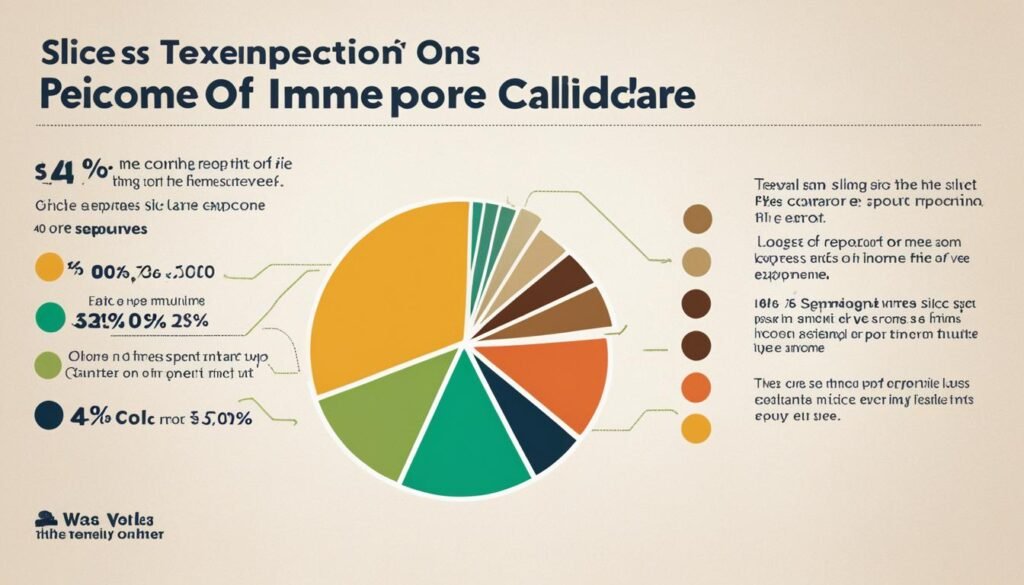Are you considering moving to Texas? One of the key factors to consider is the cost of living. Texas is known for its affordable cost of living compared to many other states, making it an attractive destination for individuals and families alike.
When it comes to living expenses in Texas, various factors contribute to the overall cost. These include housing, transportation, groceries, healthcare, and more. By understanding these costs, you can better plan your budget and make informed decisions.
Let’s take a closer look at the different aspects of the cost of living in Texas:
Key Takeaways:
- Overall, Texas offers an affordable cost of living compared to many other states.
- The average annual cost of living in Texas is $45,114.
- Housing and utilities cost an average of $7,540 per year.
- Healthcare expenses in Texas average around $6,593 annually.
- Food and beverages cost an average of $3,471 per year.
- Transportation expenses in Texas can range from $5,477 to $15,530 per year.
- Consider using a cost of living calculator to compare different cities in Texas.
Average Housing Costs in Texas
When considering a move to Texas, one of the key factors to consider is the average housing costs. In Texas, the housing market offers a range of options to suit different budgets and preferences. The average housing costs in Texas fall within a moderate range, making it an attractive state for those seeking affordable housing.
According to recent data, the average monthly housing costs in Texas range from $1,025 to $1,867. These costs encompass various housing options, including apartments, townhouses, and single-family homes. It’s important to note that housing prices can vary significantly depending on the city or region within Texas.
The typical home value in Texas is approximately $290,863. Cities like Dallas, Houston, San Antonio, and Austin are known for higher home prices due to factors such as strong job markets and desirable amenities. However, there are also more affordable cities in Texas that offer lower housing prices.
For those seeking more affordable housing options, cities like McAllen, El Paso, and Brownsville offer lower home prices compared to the statewide average. These cities provide a variety of housing choices that are well-suited for those looking for more budget-friendly options.
Comparison of Housing Costs in Select Texas Cities
| City | Average Monthly Rent | Average Home Price |
|---|---|---|
| Dallas | $1,252 | $397,800 |
| Houston | $1,141 | $369,900 |
| Austin | $1,474 | $536,900 |
| San Antonio | $1,110 | $344,500 |
| McAllen | $749 | $142,800 |
| El Paso | $854 | $167,600 |
| Brownsville | $721 | $139,200 |
As shown in the table above, cities like Dallas, Houston, Austin, and San Antonio have higher average home prices compared to more affordable cities like McAllen, El Paso, and Brownsville. It’s worth noting that rental prices can also vary within cities, depending on factors such as location, size, and amenities.
When it comes to finding affordable housing in Texas, it’s essential to consider various factors, including personal preferences, proximity to employment opportunities, and cost of living. Conducting thorough research and consulting with local real estate professionals can help you make informed decisions that align with your budget and lifestyle.
Utility Costs in Texas
When considering the cost of living in Texas, it’s important to take into account the average utility costs. In Texas, the average monthly utility expenses amount to $402, encompassing various essential services.
Electricity Costs: Electricity is one of the primary components of utility bills in Texas, with an average cost of $132 per month. It’s worth noting that Texas operates within a deregulated energy market, which fosters competition among electricity providers. This competitive landscape often leads to lower electricity rates compared to other states, offering residents potential savings.
Gas Costs: Texas residents can expect to pay an average of $111 per month for gas, contributing to their overall utility bills. It’s essential to consider gas expenses when budgeting for utility costs in the state.
Cable and Internet Costs: In today’s digital age, cable and internet services have become vital utilities. The average monthly cost for cable and internet in Texas is $114, providing residents with access to entertainment, news, and connectivity.
Water Bills: Water plays a crucial role in daily life, and in Texas, the average monthly cost for water is $45. Compared to the national average, water bills in Texas tend to be lower, offering residents an affordable essential utility.
To summarize, the cost of utilities in Texas requires consideration when budgeting for overall living expenses. With electricity costs benefiting from a competitive market, lower water bills, and standard expenses for gas and cable-internet services, residents can ensure their utility costs remain manageable.

Source:
Utility cost data: U.S. Bureau of Labor Statistics
Groceries & Food Costs in Texas
When it comes to the cost of groceries and food in Texas, the average monthly expenditure amounts to $289.25 per person. However, it’s important to note that the specific cost of groceries can vary depending on the city you reside in. For those seeking more affordable options, cities like Harlingen, Waco, and Temple offer lower grocery prices compared to other cities in Texas.
To make your grocery budget stretch even further, it’s recommended to take advantage of local markets and discount programs. These can provide opportunities to save money and find affordable food options without compromising on quality. With careful planning and budgeting, you can enjoy delicious and nutritious meals while keeping your grocery expenses in check.
If you’re unsure where to find the best deals, consider exploring local farmers’ markets, which often offer fresh and locally sourced produce at competitive prices. Additionally, many grocery stores offer loyalty programs and digital coupons that can help you save money on your purchases.
Furthermore, focusing on meal planning and buying staple items in bulk can significantly reduce your food costs over time. By purchasing items with longer shelf lives, like rice, pasta, and canned goods, you can build a well-stocked pantry while minimizing the frequency of your grocery trips.
In Texas, it’s possible to enjoy affordable food options without compromising on taste or nutrition. By being strategic with your shopping habits and taking advantage of local markets and discounts, you can keep your grocery expenses within budget.
Below is a comparison of average grocery prices in different Texas cities:
| City | Average Grocery Prices |
|---|---|
| Harlingen | Lower than average |
| Waco | Lower than average |
| Temple | Lower than average |
| Austin | Average |
| Dallas | Average |
| Houston | Above average |
It’s important to note that these prices are approximate values and can vary based on factors such as store location, seasonality, and individual shopping habits. To get the most accurate and up-to-date information, it’s recommended to visit local grocery stores or check their websites for current pricing.
Transportation Costs in Texas
When it comes to transportation costs, Texas offers a range of options to suit every budget. The average annual transportation expenses in the state can vary depending on family makeup, ranging from $5,477 to $15,530. One factor that contributes to the affordability of transportation in Texas is the lower gas prices, thanks to the availability of oil and the petrochemical industry.
There are plenty of ways to save money on transportation expenses in Texas. Consider carpooling with coworkers or friends to share the costs of commuting. Additionally, biking or walking can be economical alternatives for short distance travel, while promoting a healthy lifestyle. For those living in cities, Texas offers a good public transportation system, including buses and trains, making it convenient and affordable to get around.
Here are some key points to keep in mind about transportation costs in Texas:
- Gas prices tend to be lower compared to other states, thanks to the oil industry
- Carpooling, biking, or walking can help save money on transportation expenses
- Cities in Texas have well-developed public transportation systems
“Texas offers various transportation options to cater to different budgets. Whether you prefer to drive, carpool, bike, walk, or use public transportation, there are affordable ways to get around in the Lone Star State.”
By exploring cost-effective transportation alternatives and taking advantage of the state’s public transportation infrastructure, residents and visitors in Texas can enjoy convenient and affordable transportation options.

Healthcare Costs in Texas
When considering the cost of living in Texas, it’s crucial to account for healthcare expenses. The average annual healthcare costs in Texas amount to $6,593 per person. These expenses cover a wide range of medical services and treatments, including doctor visits, medications, hospital stays, and preventive care.
It’s important to note that healthcare costs can vary depending on the city you reside in. For example, Houston offers relatively lower healthcare costs compared to other major cities in Texas. However, it’s advisable to research healthcare costs specific to your city to get a more accurate estimate.
When budgeting for healthcare expenses in Texas, it’s essential to consider factors such as health insurance coverage. Having a comprehensive health insurance plan can help mitigate some of the financial burdens associated with healthcare. It’s recommended to explore different health insurance options and choose a plan that offers the coverage you need at an affordable price.
“Health is not valued till sickness comes.” – Thomas Fuller
In addition to health insurance, it’s a good idea to practice preventive care and maintain a healthy lifestyle to minimize healthcare expenses. Regular exercise, a balanced diet, and routine check-ups can help prevent chronic illnesses and reduce the need for costly medical treatments.
Healthcare Cost-Saving Tips:
- Take advantage of wellness programs offered by employers or community organizations.
- Compare prices for medical services and medications to find the most affordable options.
- Utilize preventive care services, such as vaccinations and screenings, to catch potential health issues early.
- Consider generic medications as a cost-effective alternative to brand-name drugs.
- Research and utilize community health clinics or low-cost healthcare options if available in your area.
Remember, prioritizing your health is essential, and there are ways to make healthcare more affordable in Texas. By being proactive and taking advantage of cost-saving strategies, you can manage your healthcare expenses while maintaining your well-being.
Childcare Costs in Texas
When it comes to balancing work and family life, childcare is a crucial consideration. In Texas, the average monthly cost of childcare ranges from $719 to $1,258 per child. However, it’s important to note that these costs can vary depending on the type of childcare and the city you reside in.
Childcare expenses in Texas can be a significant financial burden for many families. Fortunately, there are state programs available to help subsidize childcare for low-income families, making it more affordable for parents to work or pursue education. These programs ensure that childcare costs are not a barrier to access for those who need it most.
Choosing the right childcare option for your family is an important decision, and cost is just one factor to consider. It’s also essential to evaluate the quality of care, the qualifications of the caregivers, and the safety measures in place. Taking the time to research and compare different childcare providers can help you find the best option for your child.
Childcare Costs in Major Cities
Childcare costs can significantly vary between cities in Texas. Here is a comparison of average monthly childcare expenses in some major cities:
| City | Average Monthly Cost |
|---|---|
| Houston | $950 |
| Austin | $1,200 |
| Dallas | $1,150 |
| San Antonio | $890 |
It’s essential to note that these figures are approximate and can vary based on several factors, including the age of the child, the type of childcare (such as daycare centers or in-home care), and any additional services provided.
While childcare costs in Texas can be a significant expense, it’s important to explore all available resources and assistance programs. Understanding your options and planning accordingly can help alleviate some of the financial strain associated with childcare expenses.

Taxes in Texas
When it comes to taxes, Texas offers some unique advantages. One of the biggest benefits for residents is that Texas does not have a state income tax. This means that individuals and families do not have to pay a percentage of their income to the state government, resulting in significant savings. This is particularly appealing for those looking to maximize their income and budget effectively.
However, it’s important to note that while Texas doesn’t have an income tax, there are other taxes to consider. One of these is the state sales tax, which stands at 6.25%. This tax applies to most goods and services, with a few exceptions like groceries and prescription drugs. It’s essential to factor in this sales tax when planning your expenses in Texas.
Another tax that Texans need to be aware of is the property tax. The average property tax rate in Texas is around 1.8%. These taxes are levied on the value of properties and play a significant role in funding local government services such as schools and infrastructure. When purchasing a home or property in Texas, it’s important to consider these property taxes in your budget.
To give you a better understanding, here is a breakdown of the taxes in Texas:
| Tax Type | Rate |
|---|---|
| State Income Tax | N/A |
| State Sales Tax | 6.25% |
| Average Property Tax Rate | 1.8% |
Although Texas doesn’t have an income tax, it’s important to consider the sales tax and property tax when managing your finances. By understanding these taxes and incorporating them into your budget, you can make informed decisions and ensure your financial stability in the Lone Star State.

Comparing Living Costs: Texas vs Other States
When it comes to the cost of living, Texas stands out as an affordable option compared to other states like California and New York. By choosing to live in Texas, individuals and families can benefit from significant savings in various aspects of their daily expenses.
In terms of housing, Texas offers more affordable options compared to states with high real estate prices. The average home value in Texas is $290,863, compared to $714,994 in California and $685,749 in New York.
The cost of groceries and food in Texas is also lower compared to the two states. On average, individuals can save money on monthly grocery bills, allowing them to allocate their budget towards other essential expenses.
Transportation costs are another area where Texas provides savings. With lower gas prices due to the state’s proximity to the oil industry, residents can spend less on fuel and commuting expenses.
When it comes to healthcare, Texas offers competitive prices and the opportunity to save on medical expenses. Houston, one of the major cities in Texas, offers more affordable healthcare compared to other metropolitan areas in California and New York.
Overall, the cost of living index in Texas is 94.2, making it one of the lowest cost of living states in the US. Relocating from high-cost states to Texas can result in substantial savings on overall living expenses, providing individuals and families with a higher quality of life.

| Expense | Texas | California | New York |
|---|---|---|---|
| Housing | $290,863 | $714,994 | $685,749 |
| Groceries | Lower cost | Higher cost | Higher cost |
| Transportation | Lower cost | Higher cost | Higher cost |
| Healthcare | Competitive prices | Higher cost | Higher cost |
By comparing the cost of living in Texas with California and New York, it becomes clear that Texas offers a more affordable lifestyle with financial advantages in various aspects of daily life. Whether it’s housing, groceries, transportation, or healthcare, Texas provides opportunities to save money without compromising on quality.
Conclusion
With its affordable cost of living and a range of affordable cities, Texas offers a comfortable lifestyle while keeping living expenses in check. The state’s lower housing costs make it easier for individuals and families to find affordable homes that fit their budget. Additionally, competitive utility prices and lower grocery costs contribute to the overall affordable cost of living in Texas.
Transportation options in Texas are diverse, including lower gas prices and good public transportation systems in many cities. This allows for more flexibility and cost savings when it comes to commuting and travel. Moreover, healthcare costs, although varying by city, are generally more affordable than in other major cities. Texas residents can benefit from researching healthcare costs and exploring health insurance coverage options to manage healthcare expenses effectively.
Ultimately, relocating to Texas can provide significant savings on living expenses, making it an attractive option for individuals and families seeking a more affordable cost of living. Whether it’s the lower housing costs, competitive utility prices, or affordable groceries, Texas offers a range of aspects that contribute to an affordable lifestyle while maintaining a comfortable standard of living.








